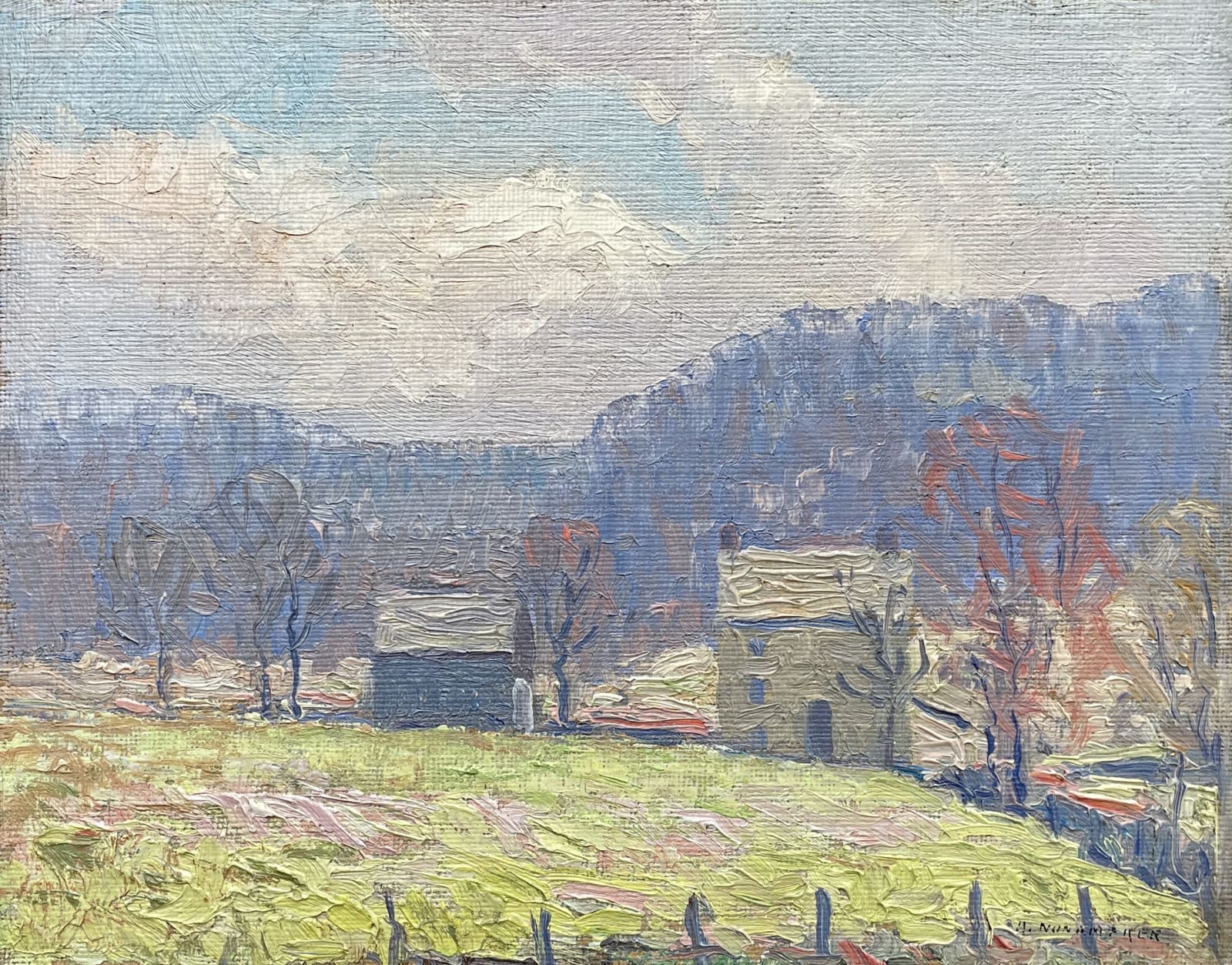Kenneth Nunamaker 1890-1957
Spring Hillside
Oil on canvas on board
8 x 10 inches
20.3 x 25.4 cm
Framed dimensions: 15 3/4 x 17 7/8 inches
20.3 x 25.4 cm
Framed dimensions: 15 3/4 x 17 7/8 inches
Signed lower right: K. Nunamaker
Spring Hillside exemplifies Nunamaker's ability to capture seasonal nuances of light and atmosphere. His simple composition of two buildings on a hillside is elevated by the delicate palette and brushwork...
Spring Hillside exemplifies Nunamaker's ability to capture seasonal nuances of light and atmosphere. His simple composition of two buildings on a hillside is elevated by the delicate palette and brushwork that emphasize the changing landscape of early spring. The vigor of Redfield and the precision of Garber echo in this fully developed smaller work.
Kenneth Nunamaker was a noted member of the New Hope School of American impressionism. Born in 1890 in Akron, Ohio, Nunamaker devoted himself to the study of nature through direct observation and plein air painting. Despite the fact that he had no formal training in art, he exhibited in several galleries in Ohio prior to his move to Pennsylvania.
In 1923, the artist moved to Center Bridge, Pennsylvania, the home of Edward Redfield, where he remodeled a century old house including a studio with panoramic views of the bucolic landscape. He lived and painted there until his death in 1957. Early on, Redfield took notice of his young neighbor and became Nunamaker's unofficial art instructor. Redfield introduced the artist to Daniel Garber and he was invited to exhibit with these established New Hope artists at the Phillip's Mill gallery. The influence of these artists on Nunamaker's work is readily apparent. His style closely resembles Redfield and embraces Redfield's philosophy of participatory observation of nature. However, his delicate palette and finer brush strokes reflect Garber's work. Many critics believe that Nunamaker was the most successful of the New Hope artists in capturing the subtle atmospheric changes of the region.
Nunamaker's exhibition record includes major solo and group shows at the Pennsylvania Academy of the Fine Arts, the Corcoran Gallery, the Salmagundi Club and the National Academy of Design.
Kenneth Nunamaker was a noted member of the New Hope School of American impressionism. Born in 1890 in Akron, Ohio, Nunamaker devoted himself to the study of nature through direct observation and plein air painting. Despite the fact that he had no formal training in art, he exhibited in several galleries in Ohio prior to his move to Pennsylvania.
In 1923, the artist moved to Center Bridge, Pennsylvania, the home of Edward Redfield, where he remodeled a century old house including a studio with panoramic views of the bucolic landscape. He lived and painted there until his death in 1957. Early on, Redfield took notice of his young neighbor and became Nunamaker's unofficial art instructor. Redfield introduced the artist to Daniel Garber and he was invited to exhibit with these established New Hope artists at the Phillip's Mill gallery. The influence of these artists on Nunamaker's work is readily apparent. His style closely resembles Redfield and embraces Redfield's philosophy of participatory observation of nature. However, his delicate palette and finer brush strokes reflect Garber's work. Many critics believe that Nunamaker was the most successful of the New Hope artists in capturing the subtle atmospheric changes of the region.
Nunamaker's exhibition record includes major solo and group shows at the Pennsylvania Academy of the Fine Arts, the Corcoran Gallery, the Salmagundi Club and the National Academy of Design.
Provenance
The artist;Private collection, gift of the artist;
By descent in the family until 2023;
Private collection, Pennsylvania, 2024
Please join our mailing list
* denotes required fields
We will process the personal data you have supplied in accordance with our privacy policy (available on request). You can unsubscribe or change your preferences at any time by clicking the link in our emails.



